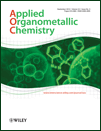Journal list menu
Export Citations
Download PDFs
Full Papers
pH-Dependent conjugate addition of arylboronic acids to α,β-unsaturated enones catalyzed by a reusable palladium(II)/cationic 2,2′-bipyridyl system in water under air
- Pages: 619-624
- First Published: 22 April 2010
Preparation and structures of a series of phosphorus-free Nickel(II) diamine complexes and their applications in hydrogenation of acetophenone
- Pages: 625-630
- First Published: 22 April 2010
Heck reaction catalyzed by a recyclable palladium supported on shell powder
- Pages: 631-635
- First Published: 24 May 2010

A novel palladium catalyst supported on shell powder has been prepared, and its application to the Heck reaction of aryl iodides with olefins has been reported. The results showed that the novel catalyst had extremely high activities for the reactions with the average yield over 90%. Also, this catalyst showed excellent stability in Heck reactions, being reused three times. The catalyst was characterized by X-ray powder diffraction and field-emission scanned electron microscopy images, and the energy dispersive X-ray analyzer.
Synthesis, structure and DNA cleavage of mononuclear Fe(III) complexes with 1,2,4-triazole-base ligand
- Pages: 636-640
- First Published: 28 April 2010

The interaction of one five-coordinated complex iron(III) with CT-DNA has been studied by using absorption and emission spectral methods. Moreover, the complex can effectively promote the cleavage of plasmid DNA in the presence and/or absence of activating agents at physiological pH and temperature.
Alkyl exchange reaction between dialkylzinc compounds and methylaluminoxane and the effect on propylene polymerization
- Pages: 641-645
- First Published: 28 April 2010

Methylaluminoxane (MAO) is usually used as a cocatalyst in catalyzed chain-growth polymerization combined with dialkylzincs. However, until now, direct experimental proof of such an exchange process and its effect on polymer structures has not been reported. The alkyl exchange reaction between dialkylzinc compounds and MAO was investigated and the effect of this alkyl exchange reaction on polymerization products was studied by 13C NMR in detail.
Polymer-supported palladium complexes with C,N-ligands as efficient recoverable catalysts for the Heck reaction
- Pages: 646-649
- First Published: 04 May 2010
Synthesis of phase-pure SnS particles employing dithiocarbamate organotin(IV) complexes as single source precursors in thermal decomposition experiments
- Pages: 650-655
- First Published: 29 April 2010
Synthesis, characterization and biological studies of alkenyl-substituted titanocene(IV) carboxylate complexes
- Pages: 656-662
- First Published: 27 May 2010

New alkenyl-substituted titanocene(IV) complexes were synthesized and characterized. The cytotoxic activity of these compounds was tested against human tumor cell lines. In addition, DNA interaction tests were carried out, observing classical electrostatic interactions of all the complexes with DNA.
Palladium–Schiff base–triphenylphosphine catalyzed oxidation of alcohols
- Pages: 663-666
- First Published: 01 June 2010

Mixed-chelate [PdCl (L) PPh3] (L = tridenrate Schiff-base ligands) complexes catalyzed the oxidation of primary and secondary alcohols to the corresponding carbonyls effectively using N-methyl-morpholine-N-oxide as oxidant under mild conditions in dichloromethane. A reaction mechanism for the catalytic oxidation has been proposed.
Book Reviews
Robert H. Crabtree The Organometallic Chemistry of the Transition Metals, 5th edn John Wiley and Sons, 2009, 520 pp. (hardback) ISBN 978-0-470-25762-3
- Page: 667
- First Published: 26 August 2010








